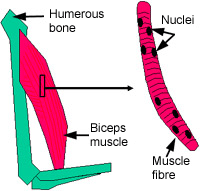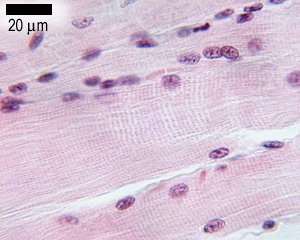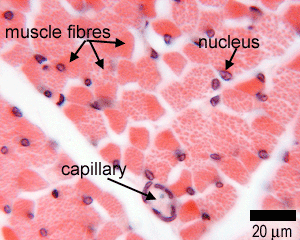Muscle: Skeletal Muscle

Skeletal muscle: moves joints by strong and rapid contractions.
Each muscle is a bundle of muscle fibres, each of which is a long
multinucleated cell.
Single mononucleated cells called myoblasts fuse together to form
this multinucleated fibre (myotube) during development. This process
also occurs to regenerate muscle fibres.
(Click here to find out about
how muscles regenerate)

If you cut a muscle longitudinally and stain it
(H&E), then you can see long muscle fibres, that look stripy.
Have a look at this H&E stained section and notice the stripes.
The stripes come from the repeating sarcomeres. Find out what a muscle sarcomere is.
The dark purple nuclei can be seen on the edges of the muscle fibres.

This picture shows a transverse section through skeletal muscle.
If you cut a muscle transversely, like this, then you can
see the roughly circular outline of the individual muscle fibres.
What to do next
Take a look at a section of the tongue - and try to identify where skeletal muscle fibres have been cut longitudinally, or transversely.
Find out how skeletal muscle is stimulated to contract .
Find out how skeletal muscle is connected to bone.
Find out about the organisation of connective tissue around the muscle fibres.


